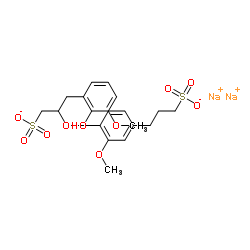Sodium lignosulfonate

Sodium lignosulfonate structure
|
Common Name | Sodium lignosulfonate | ||
|---|---|---|---|---|
| CAS Number | 8061-51-6 | Molecular Weight | 534.508 | |
| Density | N/A | Boiling Point | 1704ºC | |
| Molecular Formula | C20H24Na2O10S2 | Melting Point | 993ºC | |
| MSDS | Chinese USA | Flash Point | N/A | |
|
The inhibitory effect of the various seed coating substances against rice seed borne fungi and their shelf-life during storage.
Pak. J. Biol. Sci. 12(16) , 1102-10, (2009) Presently, chemical seed treatments are in discussion due to their directly or indirectly impacts on human health or other living organisms. They may also negatively affect the ecosystem and the food chain. In rice seeds, chemicals may cause phytotoxic effect... |
|
|
Preparation, processing and properties of lignosulfonate-flax composite boards.
Carbohydr. Polym. 93(1) , 300-6, (2013) Hemp, hay, straw for animal litters, raffia and sisal stems, abaca and jute bleached pulp fibres, miscanthus stems and flax fibres were mixed to lignosulfonate at 70% filler concentration and compressed in the form of 5 cm-thick boards. Flax was found to give... |
|
|
Fabrication, characterization and application of nitrogen-containing carbon nanospheres obtained by pyrolysis of lignosulfonate/poly(2-ethylaniline).
Bioresour. Technol. 127 , 66-71, (2013) Lignosulfonate/poly(2-ethylaniline) (LS-PEA) composite nanospheres were prepared via in situ polymerization of 2-ethylaniline (EA) with lignosulfonate (LS) as a dispersant. LS-PEA nanospheres with an average diameter of 155 nm were obtained at an optimal LS c... |
|
|
Wheat (Triticum aestivum L.) response to a zinc fertilizer applied as zinc lignosulfonate adhered to a NPK fertilizer.
J. Agric. Food Chem. 58(13) , 7886-92, (2010) The efficacy as Zn fertilizers for wheat of zinc lignosulfonate (ZnLS) products adhered to NPK was evaluated by three plant experimental designs. In the first and second assays, wheat plants were grown under controlled conditions with perlite and a calcareous... |
|
|
Oxygen-scavenging coatings and films based on lignosulfonates and laccase.
J. Biotechnol. 161(1) , 14-8, (2012) Laccase and lignosulfonates were included in coating colors and embedded in latex-based or starch-based films and coatings on foil or board. After 6 days at 23 °C and 100% relative humidity, the oxygen content in airtight chambers decreased from 1.0% (synthet... |
|
|
Effects of corn grain particle size and treated soybean meal on carcass and meat quality characteristics of beef steers finished on a corn silage diet.
Meat Science 88(4) , 750-4, (2011) Thirty-nine steers were distributed into a 2 x 2 factorial arrangement of treatments to determine the effect of corn grain particle size (cracked [CC] vs ground [GC] corn) and soybean meal treatment (solvent extracted soybean meal [SS] vs lignosulfonate treat... |
|
|
Preparation of starch-sodium lignosulfonate graft copolymers via laccase catalysis and characterization of antioxidant activity.
Carbohydr. Polym. 91(2) , 581-5, (2013) Graft copolymers of waxy maize starch and sodium lignosulfonate (SLS) were prepared by Trametes versicolor laccase catalysis in aqueous solution. Amount of SLS grafted based on phenol analysis was 0.5% and 1.0% in the absence and presence of 1-hydroxybenzotri... |
|
|
Use of the stable isotope (57) Fe to track the efficacy of the foliar application of lignosulfonate/Fe(3+) complexes to correct Fe deficiencies in cucumber plants.
J. Sci. Food Agric. 91(3) , 395-404, (2011) During the last decade, environmental concerns regarding the use of recalcitrant synthetic chelates to overcome iron chlorosis has increased and new ligands such as lignosulfonates (LS) have been evaluated. However, the efficacy of these products is variable.... |
|
|
Enzymatic synthesis of lignin-siloxane hybrid functional polymers.
Biotechnol. J. 7(2) , 284-92, (2012) This study combines the properties of siloxanes and lignin polymers to produce hybrid functional polymers that can be used as adhesives, coating materials, and/or multifunctionalized thin-coating films. Lignin-silica hybrid copolymers were synthesized by usin... |
|
|
Lignosulfonic acid exhibits broadly anti-HIV-1 activity--potential as a microbicide candidate for the prevention of HIV-1 sexual transmission.
PLoS ONE 7(4) , e35906, (2012) Some secondary metabolites from plants show to have potent inhibitory activities against microbial pathogens, such as human immunodeficiency virus (HIV), herpes simplex virus (HSV), Treponema pallidum, Neisseria gonorrhoeae, etc. Here we report that lignosulf... |